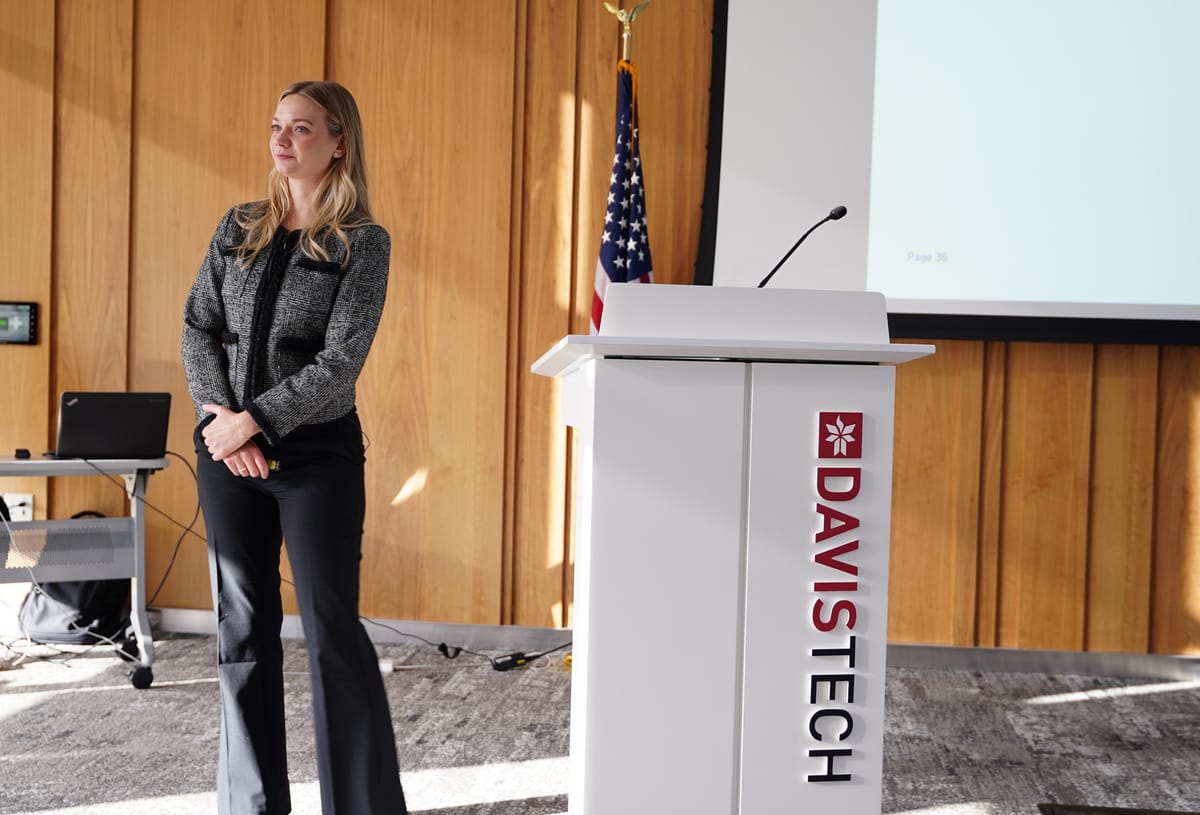

This week the Bank of Utah welcomed economist Lauren Henderson of Stifel Financial in Chicago to address a range of current topics in economics in conjunction with the Bank of Utah's practice of hosting economists and other financial experts throughout the year.
As part of this Economic Forecast Series, the Bank of Utah also hosted other sessions in Salt Lake City, Ogden and Kaysville, which included Dr. Lindsey Piegza from Stifel and Michael Jeanfreau from Workforce Services.
Ms. Henderson presented to a large room packed with Bank of Utah employees and bank customers at Davis Tech Campus Allied Health Building in Kaysville. She discussed the U.S. economy's resilience amid aggressive fiscal policies, potential economic policies under the new Trump administration, and the rise of AI. She highlighted three main themes: consumer spending, inflation, and fiscal policy decisions.
Focusing on the Consumer
Ms. Henderson opened her presentation on a positive note by recognizing the resilience of the US consumer amidst economic uncertainty.
“The US consumer remains resilient, and this is largely due to the gains in the labor market. In fact, we saw that non-farm payrolls rose 143,000 in the latest reports,” she explained. Non-farm payrolls (NFP) are a monthly report that shows the number of jobs added or lost in the US economy.
In 2024 the US economy created 166,000 jobs on average, and average hourly earnings rose a half a percentage point in the latest report.

Despite these positive figures, the US consumer is still struggling for financial stability.
“The consumer certainly is feeling pain from the elevated interest rates, elevated prices, and increasingly turning to credit cards, buy now, pay later, options, as well as one time household well transfers, particularly from Baby Boomers to millennial generation, increasingly relying on inorganic supports to support their spending habits.”
“We've actually seen credit card debt has risen to $1.2 trillion—about an 8% increase from this time last year.”
Delinquency rates have recently crept higher, with 3.5% of outstanding debt in some state of delinquency as of the third quarter. Henderson reports that many consumers are unsure about their future financial plans, and are changing their spending habits on a volatile monthly basis.

“Consumers are shifting the goods and services in their basket on a monthly basis. Again, something we're doing when we're a little bit concerned about our future financial footing."
Henderson is careful not to oversell the strength of the labor market, despite job creation highs, “A slowdown in consumption, a slowdown in consumer spending, does risk undermining growth sooner than later.” Henderson is also careful not to generalize all consumer spending, but instead suggests that we consider two different consumers: “not necessarily Rich versus Poor, but really asset holders versus non asset holders.”
“Healthcare net worth has risen to a record high of $169 trillion, as compared to 25 trillion since the start of 2023 and this is largely a reflection of massive appreciation and assets such as housing inequities.”
“Unfortunately, if you don't have a stake in the stock market or own a home, you're less likely to benefit from this massive appreciation and household net worth," said Henderson.
Utah Housing Market

Henderson reports that high interest rates have “wreaked havoc” on the housing market, as housing is one of the “most interest rate sensitive” sectors of the US economy.
“Looking at the home price index for Salt Lake City area, we see that home prices are up about 5% from this time last year, so above the national average of 3.9% and above a nearby city of Phoenix at 3.8% While in Chicago and other cities like New York, we're seeing that the average index is up about 7%.”
Impact of AI on Labor Market and Business Investment

Businesses are struggling under higher prices and interest rates, with smaller businesses being more affected. Larger businesses are turning to technology, particularly AI, to reduce costs and improve efficiency.
“Last year, the ruling in California increased the minimum wage for a fast food worker from $16 an hour to $20 an hour…Since then, we've heard many reports of fast food chains wanting to transition to AI powered drive throughs.”
“Tax-fueled spending that could prove inflationary, and we also know that extending the tax cuts and Jobs Act could add anywhere from two to 4 trillion to US debt over the next 10 years.”
“The increase in labor has sped up the transition for some companies to turn to technology and essentially eliminate that human labor component, if they can. So for many companies, AI has been a cost saving lifeline.”
“50% of businesses, in fact, have reported that they've adjusted their staff based on the adoption of AI, with 80% of businesses expected to do so in the coming year.”
“So again, we know that AI has been a cost saving lifeline, but it also has the potential to disrupt the labor market, with approximately 12 million jobs this year, potentially being affected by artificial intelligence.”
What to expect with Inflation and Trump’s Policies
“On the inflation front,” Henderson continued, “inflation has come down from the most peak levels, but the lack of disinflationary improvement as of late does complicate the pathway for the Federal Reserve still trying to implement further rate cuts this year.”

Henderson warned the room that the risk of recession is still “very real.” Developed nations in total, including the US, are still recovering from COVID-19 spending of $17 trillion dollars.
President Trump's proposed policies, such as increasing tariffs and extending the tax cuts and Jobs Act, could impact inflation and the economy.
“We do know that President Trump has promised a lot along the campaign trail. What we don't know is how these policies will be implemented and to what extent.”
How do these policies affect the economy? Henderson answers: it depends.
“If these tariffs do result in a greater tit-for-tat trade war, this does risk inflation going up higher.”
“The Trump administration has been a vocal supporter of budget cuts, of government cuts, which could help offset some of the losses from extending the tax cuts and Jobs Act.”
“Immigration restrictions could exacerbate the already existing labor supply shortage and could potentially lead to higher production costs and higher wage pressures.”
Henderson ultimately concludes that it is too early in the President’s second term to say. We will have to wait and see.

About Lauren Henderson

Lauren Henderson is an Economist for Stifel Financial Corp., an American multinational independent investment bank and financial services company created under the Stifel name in July 1983 and listed on the New York Stock Exchange on November 24, 1986. It is headquartered in St. Louis, Missouri and has offices throughout the US, Europe and Canada.
Henderson focuses on the research and analysis of economic trends and activity, world economies, financial markets, and monetary and fiscal policies. She has been with the Stifel Financial Economics Department for nine years and provides commentary and interpretative analysis on economic data, as well as supportive insights for economic forecasting.
Henderson holds two degrees from Loyola University Chicago in marketing and economics, and earned her MBA with a focus in economics from Loyola University Chicago.

